In recent years, big leaf houseplants have gained popularity and are now found in homes worldwide. These plants bring a tropical feel to any space, with their lush foliage creating a vibrant and lively atmosphere indoors. Whether you’re a seasoned plant enthusiast or new to indoor gardening, these tropical big leaf houseplants are an excellent way to beautify and enhance the style of your home.
The Benefits of Having Tropical Big Leaf Houseplants
Aside from their aesthetic appeal, tropical big leaf houseplants offer a range of benefits that make them a worthwhile addition to any home. Here are a few reasons to consider incorporating these plants into your indoor decor:
1. Improved Air Quality: Tropical big leaf houseplants are known for their ability to purify the air by removing harmful toxins and releasing oxygen. Plants such as the Monstera deliciosa and the Fiddle Leaf Fig are excellent choices for improving indoor air quality and creating a healthier living environment.
2. Natural Humidifiers: Many tropical big leaf houseplants release moisture into the air through a process called transpiration. This can help increase humidity levels in dry indoor spaces, benefiting both the plants and the inhabitants. The Areca Palm and the Elephant Ear are examples of tropical houseplants that can naturally humidify a room.
3. Stress Relief: Indoor plants have been shown to reduce stress levels and promote relaxation. The lush and vibrant foliage of tropical big leaf houseplants can create a calming and soothing atmosphere, making them perfect for bedrooms and living areas.
4. Visual Appeal: Tropical big leaf houseplants are known for their stunning foliage, which often features intricate patterns, vibrant colors, and unique textures. Whether you choose a Philodendron or a Banana Plant, these plants can become striking focal points in any room, adding a touch of exotic beauty.
In conclusion, the rising trend of tropical big leaf houseplants is a testament to their undeniable appeal and the numerous benefits they offer. From improving air quality to adding visual appeal, these plants have become a must-have for plant enthusiasts and interior decorators alike. So why not bring a piece of the tropics into your home and experience the joy of caring for and enjoying these beautiful plants?
MORE POSTS: 100 Gardening Captions for Instagram
1. Monstera Deliciosa
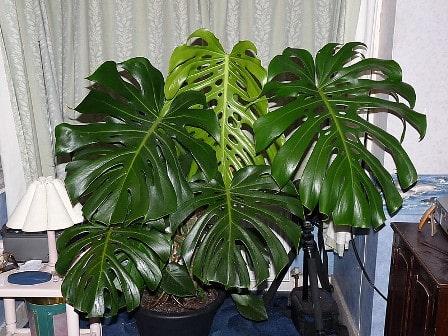
Are you looking to bring a touch of the tropics into your home? Look no further than the Monstera Deliciosa, also known as the Swiss cheese plant. This stunning houseplant is a popular choice among plant enthusiasts due to its large, glossy leaves with unique cutouts. With its tropical origins, the Monstera Deliciosa adds a touch of exotic beauty to any indoor space.
The Monstera Deliciosa is native to the rainforests of Central America and Mexico. Its large, heart-shaped leaves are its defining feature, with deep green coloration and distinctive fenestrations, giving it the appearance of Swiss cheese. The plant typically grows vertically, but with the right conditions, it can also climb and spread out.
This houseplant is relatively easy to care for, making it suitable for both beginner and experienced plant enthusiasts. It thrives in bright, indirect light but can tolerate lower light conditions. It prefers a moderate level of humidity, so misting the leaves or placing the plant near a humidifier is beneficial. The Monstera Deliciosa also appreciates well-draining soil, regular watering, and occasional fertilization during the growing season.
Care and Maintenance of Monstera Deliciosa
To keep your Monstera Deliciosa happy and healthy, it’s important to ensure the following care and maintenance:
- Light: Place your Monstera Deliciosa in bright, indirect light. Direct sunlight can scorch the leaves.
- Watering: Water your plant when the top inch of soil feels dry. Avoid overwatering, as it can lead to root rot. Ensure proper drainage by using a well-draining potting mix.
- Humidity: Provide moderate humidity levels for your Monstera Deliciosa. Consider misting the leaves or using a humidifier to increase humidity.
- Temperature: This tropical plant prefers temperatures between 65-85°F (18-29°C). Avoid temperature extremes and drafts.
- Pruning: The Monstera Deliciosa can develop long aerial roots and vines. Prune the plant to maintain its shape and remove any leggy or damaged growth.
With its lush foliage and distinctive appearance, the Monstera Deliciosa is not only a beautiful houseplant but also helps purify the air by removing toxins. Its ability to adapt to different light conditions and relatively low maintenance needs make it a popular choice for indoor greenery enthusiasts.
So, if you’re longing for a tropical touch in your home, consider adding a Monstera Deliciosa to your collection. Its unique leaves and easy-care nature make it an excellent addition to any indoor space.
MORE POSTS: 15 Best Potted Plants for a Shaded Porch
2. Alocasia Polly
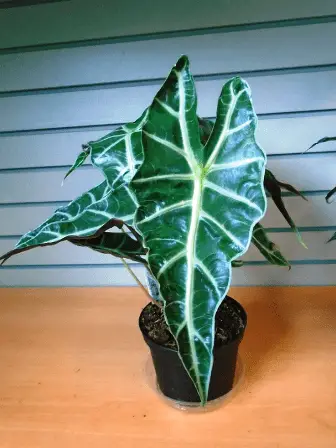
Alocasia Polly, also known as African Mask or Elephant Ear plant, is a popular choice for indoor plant enthusiasts looking to add a touch of tropical elegance to their homes. Native to the rainforests of Southeast Asia, this houseplant is admired for its distinctive large, heart-shaped leaves and bold veining patterns. The leaves can grow up to a foot long, creating a dramatic display in any room.
In terms of care, Alocasia Polly thrives in bright, indirect light, making it an excellent choice for well-lit living rooms or near east-facing windows. It prefers warmth and humidity, so placing it in a bathroom or providing regular misting can help recreate its natural habitat. It’s important to keep the soil consistently moist but not overly saturated to prevent root rot. Using well-draining soil and a pot with drainage holes can help with proper water management.
Care and Maintenance of Alocasia Polly
To ensure the healthy growth of your Alocasia Polly, here are some key care tips to keep in mind:
- Watering: Keep the soil consistently moist, but avoid overwatering. Allow the top inch of soil to dry out before watering again. Remember to adjust watering frequency based on the temperature and humidity of your home.
- Light: Alocasia Polly prefers bright, indirect light. Direct sunlight can scorch its leaves, so it’s best to place it a few feet away from a sunny window or use sheer curtains to filter the light.
- Temperature and Humidity: This tropical plant thrives in temperatures between 60-85°F (15-29°C) and high humidity. Consider using a humidifier or placing the pot on a tray filled with water and pebbles to increase humidity.
- Fertilizer: Feed your Alocasia Polly every two to four weeks during the growing season (spring and summer) with a balanced houseplant fertilizer. Reduce or stop fertilization during winter when the plant is in its dormant phase.
- Pruning: Prune any yellow or wilted leaves as they may be a sign of overwatering or inadequate light. Regularly inspect the plant for pests like spider mites or aphids and take appropriate measures if needed.
With proper care, Alocasia Polly can be a stunning addition to your indoor plant collection, bringing a touch of the tropics into your home. Remember to periodically check for signs of stress or pests and adjust care accordingly. Happy growing!
3. Philodendron Xanadu
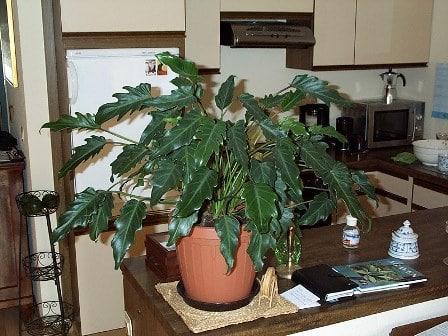
Philodendron Xanadu is a popular tropical houseplant known for its lush, large, and deeply lobed leaves. Its attractive appearance and relatively compact size make it an excellent choice for indoor spaces. The plant is native to Brazil and belongs to the Araceae family. It is often used as a decorative plant in offices, homes, and gardens due to its ability to thrive in low-light conditions and its air-purifying properties.
The foliage of Philodendron Xanadu is its main highlight. The leaves are glossy, dark green, and deeply lobed, giving them a unique and eye-catching appearance. The plant forms dense, bushy clumps, making it an excellent choice for adding greenery to any indoor space.
Care and Maintenance of Philodendron Xanadu
Philodendron Xanadu is relatively easy to care for, making it suitable for both experienced and novice plant enthusiasts. Here are some essential care tips for keeping your Philodendron Xanadu healthy:
- Light: Philodendron Xanadu thrives in bright, indirect light. While it can tolerate some shade, too much direct sunlight can scorch its leaves. Place the plant near a window where it can receive bright, filtered light throughout the day.
- Watering: Water the plant when the top inch of the soil feels dry. Avoid overwatering, as it can lead to root rot. Ensure that the pot has proper drainage to prevent waterlogging.
- Temperature and Humidity: Philodendron Xanadu prefers temperatures between 65-85°F (18-29°C). It appreciates higher humidity levels, so consider misting the leaves or using a humidifier if you live in a dry climate.
- Soil and Fertilizer: Use well-draining potting soil to prevent waterlogging. Fertilize with a balanced liquid fertilizer once a month during the growing season (spring and summer).
- Pruning: Trim any yellow or dead leaves to maintain the plant’s appearance. You can also prune to control its size and promote bushier growth.
Philodendron Xanadu is a non-toxic plant, but it’s always a good idea to keep it out of reach of pets and children.
With proper care, Philodendron Xanadu can thrive for many years, bringing a touch of tropical beauty to your indoor space. Its attractive foliage, low maintenance requirements, and air-purifying qualities make it a popular choice among houseplant enthusiasts.
4. Ficus Lyrata (Fiddle Leaf Fig)
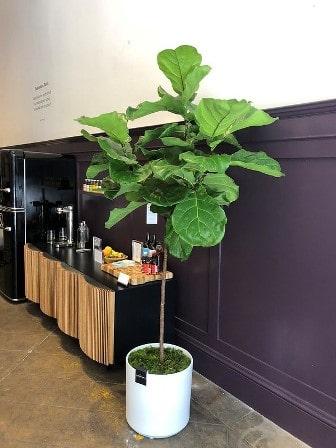
If you’re looking to add a touch of tropical elegance to your home, the Ficus Lyrata, also known as the Fiddle Leaf Fig, is a perfect choice. This houseplant is renowned for its large, lush green leaves that resemble the shape of a fiddle. It’s a popular choice among plant lovers and interior designers for its stunning visual appeal.
The Ficus Lyrata is native to tropical rainforests in West Africa. It can reach an impressive height of six feet indoors, making it a striking focal point in any room. The Fiddle Leaf Fig has broad, leathery leaves that can grow up to 18 inches long and seven inches wide. Its leaves are deep green and glossy, adding a touch of elegance and drama to any space.
This plant thrives in bright, indirect light, but it can adapt to lower light conditions. It’s important to avoid placing it in direct sunlight, as this can lead to leaf burn. The Fiddle Leaf Fig prefers well-draining soil and requires regular watering to keep the soil evenly moist, but not waterlogged. It’s recommended to allow the top inch of soil to dry out between waterings.
Care and Maintenance of Ficus Lyrata
To ensure the health and vibrancy of your Ficus Lyrata, it’s essential to provide proper care and maintenance. Here are some tips to keep in mind:
- Light: Place your Fiddle Leaf Fig in a location that receives bright, indirect light. Rotate the plant occasionally to ensure even growth.
- Watering: Water your Ficus Lyrata when the top inch of soil feels dry to the touch. Avoid overwatering, as it can lead to root rot. It’s better to underwater than to overwater this plant.
- Humidity: The Fiddle Leaf Fig thrives in environments with moderate to high humidity. Consider using a humidifier or placing the plant on a tray filled with water and pebbles to increase humidity levels.
- Fertilization: Feed your Ficus Lyrata with a balanced liquid fertilizer during the spring and summer months. Follow the instructions on the fertilizer packaging for proper application.
- Pruning: Prune your Fiddle Leaf Fig to maintain its shape and remove any damaged or yellowing leaves. You can also trim the top of the plant to encourage bushier growth.
With proper care, your Ficus Lyrata can thrive and become a stunning addition to your indoor space. Remember to monitor its moisture levels, light exposure, and provide regular care to ensure its longevity.
Whether you’re a seasoned plant enthusiast or just starting your houseplant journey, the Ficus Lyrata is a captivating choice that will bring a touch of tropical beauty to your home.
5. Calathea Orbifolia
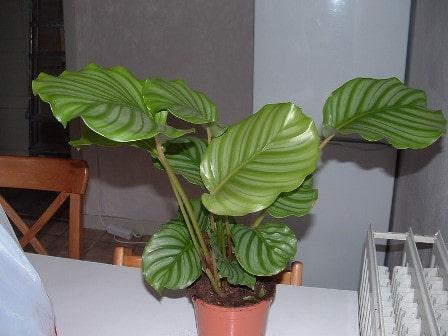
If you’re looking to add a touch of tropical beauty to your indoor space, the Calathea Orbifolia is an excellent choice. This stunning houseplant features large, round leaves with bold, silver stripes that will instantly catch your attention. Its eye-catching foliage adds a vibrant and exotic touch to any room.
The Calathea Orbifolia, also known as the Prayer Plant, is native to tropical regions in South America. Its unique leaf pattern and size make it a popular choice among plant enthusiasts. The leaves can grow up to 12 inches in length and are held upright on long stems. The silver stripes on the dark green leaves create a mesmerizing contrast, making it a true statement piece in your indoor garden.
Care and Maintenance of Calathea Orbifolia
Caring for the Calathea Orbifolia requires attention to its specific needs to ensure it thrives in your home. Here are some essential care tips:
- Light: The Calathea Orbifolia prefers medium to bright indirect light. Avoid direct sunlight, as it can scorch the leaves. Place it near a window with filtered sunlight for optimal growth.
- Temperature and Humidity: This houseplant thrives in warm temperatures ranging from 65°F to 80°F (18°C to 27°C). It also prefers high humidity levels. Consider using a humidifier or placing the plant on a tray filled with water and pebbles to increase humidity.
- Watering: Keep the soil consistently moist but not soggy. Water the plant when the top inch of the soil feels dry to the touch. Overwatering can lead to root rot, so ensure proper drainage.
- Soil and Fertilizer: Plant your Calathea Orbifolia in well-draining soil to prevent waterlogging. Use a balanced houseplant fertilizer diluted to half strength during the growing season (spring and summer) to promote healthy growth.
- Pruning and Propagation: Remove any yellow or brown leaves regularly to maintain the plant’s overall health. You can propagate the Calathea Orbifolia through division during repotting.
The Calathea Orbifolia is known for its sensitive nature, as its leaves may curl or droop to react to environmental changes or stress. However, with consistent care and the right conditions, this tropical beauty will flourish and bring an exotic charm to your indoor space.
Whether you’re an experienced plant parent or a beginner, the Calathea Orbifolia is a fantastic choice if you want to incorporate tropical big leaf houseplants into your home decor. Its stunning foliage and unique markings will captivate anyone who lays eyes on it.
So, why not bring the tropical vibes into your living space with the stunning Calathea Orbifolia? Start caring for this remarkable houseplant and enjoy its beauty and lush greenery year-round.
MORE POSTS: 20 Low Maintenance Cottage Garden Ideas
Conclusion
When it comes to tropical big leaf houseplants, there are several popular options that can add a touch of lush greenery to your home.
1. Monstera Deliciosa: Also known as the Swiss cheese plant, Monstera Deliciosa is known for its large, fenestrated leaves that give it a unique and eye-catching appearance. It thrives in bright, indirect light and should be watered thoroughly but allowed to dry out between waterings.
2. Alocasia Polly: Alocasia Polly, also known as the African mask plant, features large, arrowhead-shaped leaves with prominent veins. It prefers bright, indirect light and should be watered regularly to keep the soil evenly moist.
3. Philodendron Xanadu: Philodendron Xanadu is a compact houseplant with large, deeply lobed leaves. It is a low-maintenance plant that can tolerate a variety of light conditions, making it suitable for different areas of your home. It should be watered regularly but allowed to dry out slightly between waterings.
4. Ficus Lyrata: Commonly known as the fiddle-leaf fig, Ficus Lyrata has large, violin-shaped leaves that make it a popular choice for interior decorating. It thrives in bright, indirect light and should be watered when the top inch of soil becomes dry.
5. Calathea Orbifolia: Calathea Orbifolia features large, round leaves with silver stripes that add an elegant touch to any room. It prefers bright, indirect light and requires consistently moist soil to thrive.
Here’s a quick table to compare these tropical big leaf houseplants:
| Houseplant | Features | Light Requirements | Watering Needs |
|---|---|---|---|
| Monstera Deliciosa | Fenestrated leaves | Bright, indirect light | Thorough watering |
| Alocasia Polly | Arrowhead-shaped leaves | Bright, indirect light | Regular watering |
| Philodendron Xanadu | Deeply lobed leaves | Various light conditions | Regular watering |
| Ficus Lyrata | Violin-shaped leaves | Bright, indirect light | Regular watering |
| Calathea Orbifolia | Round leaves with stripes | Bright, indirect light | Consistently moist soil |
If you have tropical big leaf houseplants, there are some important things to keep in mind to keep them healthy. These plants do well in a humid environment, so it’s a good idea to mist their leaves regularly or place them near a humidifier. Also, be careful not to overwater them, as this can cause root rot. Before watering, check the moisture level of the soil and adjust accordingly. Lastly, pay attention to each plant’s light requirements and make sure to keep them in an area of your home that provides the right amount of light.
Taking care of tropical big leaf houseplants can be rewarding and bring a touch of the tropics into your living space. With the right care and attention, these plants can thrive and provide you with years of beauty and enjoyment.


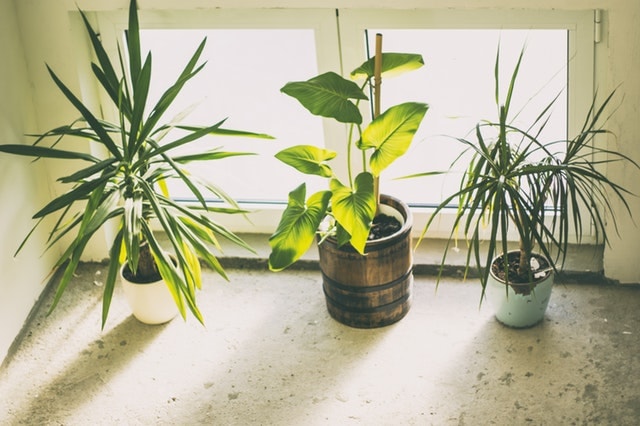
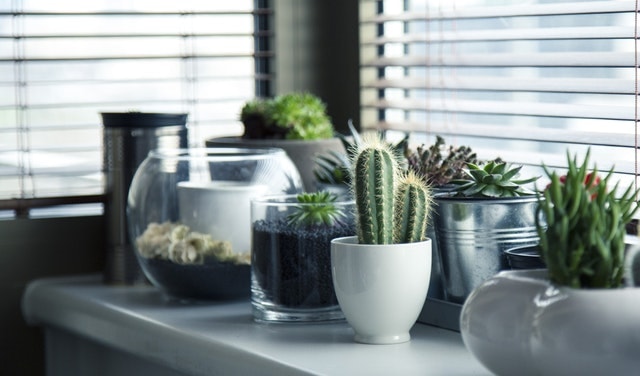

Pingback: Philodendron Xanadu Propagation and Care Tips [Updated]